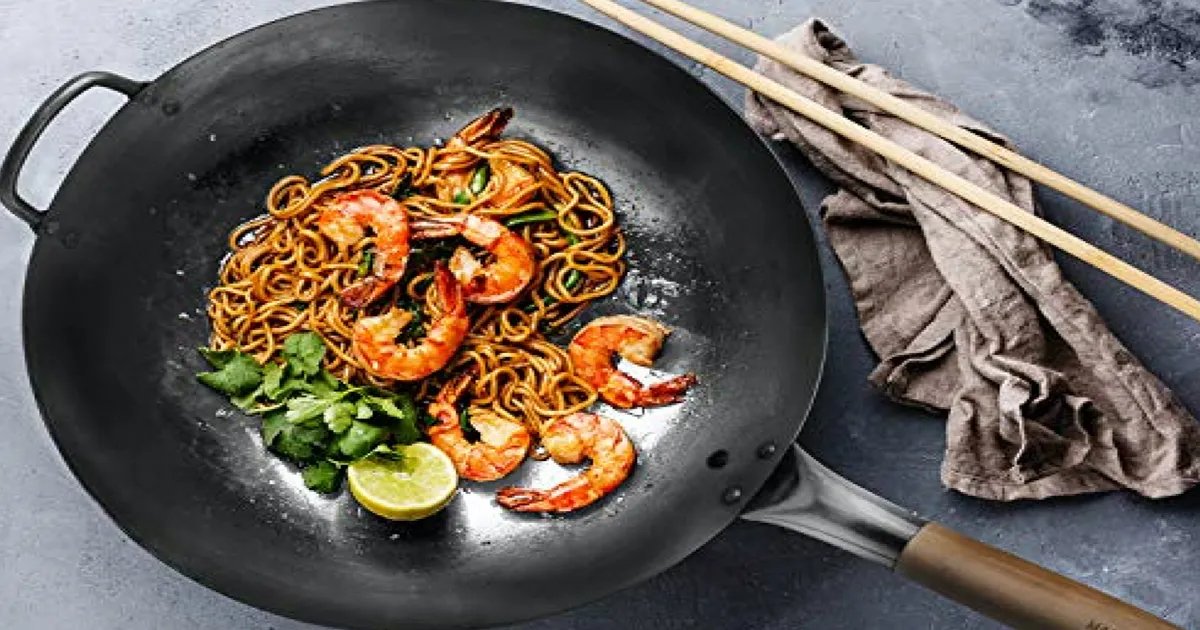What are the differences between carbon steel vs cast iron wok? Do you love cooking as much as we do? There’s nothing better than spending a weekend afternoon in the kitchen, cooking up a storm. Whether you’re whipping up a quick meal or trying out a new recipe, it’s always more fun when you have the right tools for the job.
When it comes to cookware, one of the most important choices you’ll make is deciding between a carbon steel wok and a cast iron wok. Both have their pros and cons, so it’s important to know the difference before you make your purchase. Here’s a quick rundown of the differences between carbon steel and cast iron woks:
What is Carbon Steel Wok?
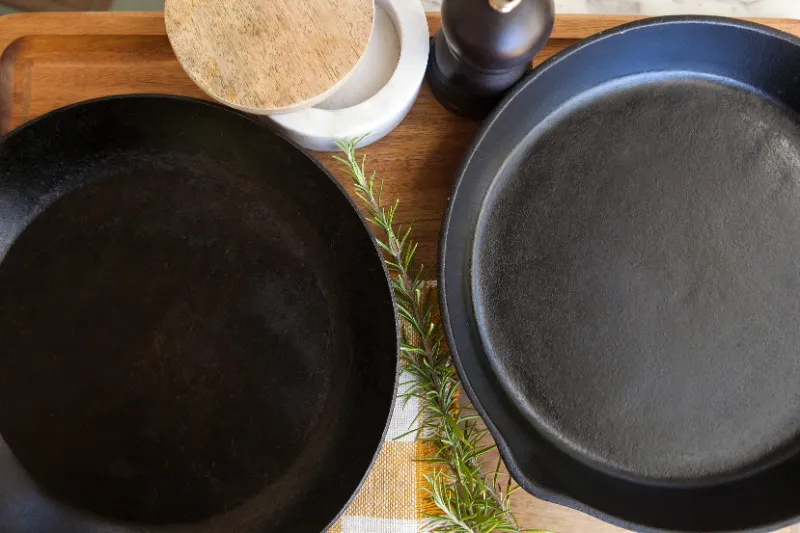
Carbon steel wok is a type of wok that is made from carbon steel. It is a popular choice for many people because it is durable and has excellent heat conductivity. Carbon steel woks are available in a variety of sizes and shapes. They are also relatively inexpensive, making them a good option for people who want to experiment with woks without spending a lot of money.
Carbon steel wok is made with a round bottom. This allows the heat to be distributed evenly, making it ideal for stir-frying. The sides of the wok are usually flared, which makes it easier to toss ingredients around. Carbon steel woks need to be seasoned before they are used. This helps to create a non-stick surface and prevents the wok from rusting.
Carbon steel wok has a long history back to the Han Dynasty in China. It is said that the first woks were made from bell metal, which is a type of bronze. Woks became popular in Europe during the late Middle Ages and were used for cooking stews and other dishes.
[amazon bestseller=”Carbon steel wok” items=”5″ ]
Today, carbon steel woks are still widely used in Asian cuisine. They are often used for stir-frying, as well as for deep-frying and steaming. When choosing a carbon steel wok, it is important to select one that is the right size for your needs. It is also important to season the wok before using it, as this will help to create a non-stick surface.
When seasoning a carbon steel wok, it is important to use a cooking oil that has a high smoke point. This will help to prevent the oil from burning and creating harmful fumes. Once the wok is seasoned, it should be cleaned with hot water and soap. It is not necessary to use a harsh detergent, as this can strip away the seasoning. After cleaning, the wok should be dried thoroughly to prevent rusting.
Carbon steel woks are a great choice for people who want an inexpensive and durable option. They are easy to season and care for, and they conduct heat evenly. If you are looking for a wok that will give you years of use, carbon steel is a good choice.
What is Cast Iron Wok?
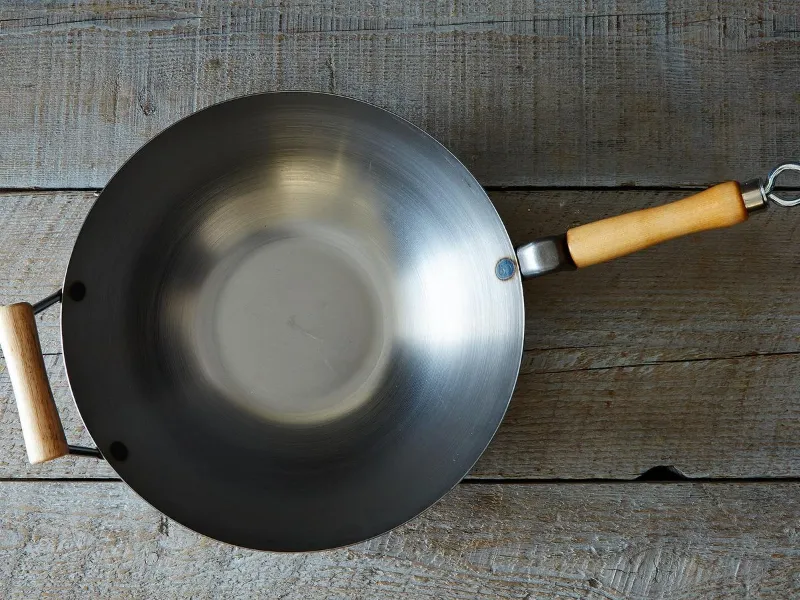
Cast iron wok is a type of wok that is made from cast iron. It is a popular choice for stir-frying because it heats up quickly and evenly, making it ideal for cooking food at high temperatures. Cast iron woks are also durable and long-lasting, so they can be a good investment if you do a lot of stir-frying.
While cast iron woks are a great choice for stir-frying, they do require some special care. They should be seasoned before use, and they should be cleaned with soap and water after each use. You should also avoid using metal utensils on a cast iron wok, as this can damage the seasoning.
This type of wok is not restricted to only being used for stir-frying. It can be used for other cooking methods as well, such as steaming, deep-frying, and even baking.
Cast iron wok is made with a little lip on one side. This is because traditionally it was hung over an open fire to cook food. The lip allowed the heat to circulate evenly around the entire wok, so the food cooked evenly. However, nowadays most cast iron woks come with a flat bottom so that they can be used on a stovetop.
[amazon bestseller=”Cast iron wok” items=”5″ ]
Cast iron woks are available in a variety of sizes. The size you choose will depend on how much food you want to be able to cook at one time. They also come with either a round or flat bottom. Round-bottomed woks are better for stir-frying, while flat-bottomed woks can be used for other methods of cooking as well.
No matter what size or shape you choose, a cast iron wok is a great addition to any kitchen. With proper care, it will last for years and provide you with delicious meals.
Cast iron wok has a long history back to the Han Dynasty in China. It is said that the first cast iron wok was made over 2000 years ago. Today, cast iron woks are still a popular choice for cooking, both in China and around the world.
If you’re interested in trying a cast iron wok, be sure to read our guide on how to season a cast iron wok. And if you’re looking for more information on woks in general, check out our articles on the best woks and how to use a wok.
If you’re looking for a cast iron wok, be sure to check out our selection. We have a variety of sizes and styles to choose from, so you can find the perfect wok for your needs.
Benefits of Using Carbon Steel and Cast Iron Wok
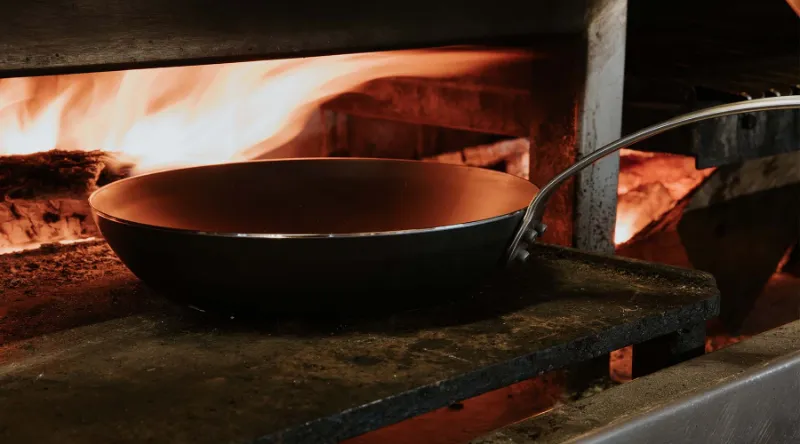
Heat up quickly
Carbon steel and cast iron woks have a number of advantages over other types of woks. One advantage is that they heat up quickly and evenly. This means that you can cook food more evenly, which is especially important when you are stir-frying. In addition, carbon steel woks retain heat better than other types of woks, so your food will stay hot longer after you have finished cooking it.
Easy to clean
Carbon steel and cast iron woks are also relatively easy to clean, so you won’t have to spend a lot of time scrubbing them after each use. Simply wipe them down with a damp cloth and they will be good as new. These type of woks are also less likely to rust than other materials, so you can be sure that they will last for many years with proper care.
If you are looking for an easy-to-clean wok, then carbon steel or cast iron is a good option. These materials are also less likely to rust, so you can be sure that your wok will last for many years with proper care.
Non-stick surface
Another advantage of carbon steel and cast iron woks is that they have a non-stick surface. This means that you won’t have to use as much oil when you are cooking, which can be healthier for you. In addition, the non-stick surface makes it easier to clean the wok.
All these wok are specially designed with a flat base and flared sides which make it easy to toss food while cooking. This allows you to evenly cook your food without having to worry about it sticking to the wok or burning.
The choice of wok is really up to you and what you plan on using it for. If you are only going to be cooking for one or two people, then a small wok would be fine. However, if you plan on cooking for a larger family or group of people, then you might want to consider getting a larger wok.
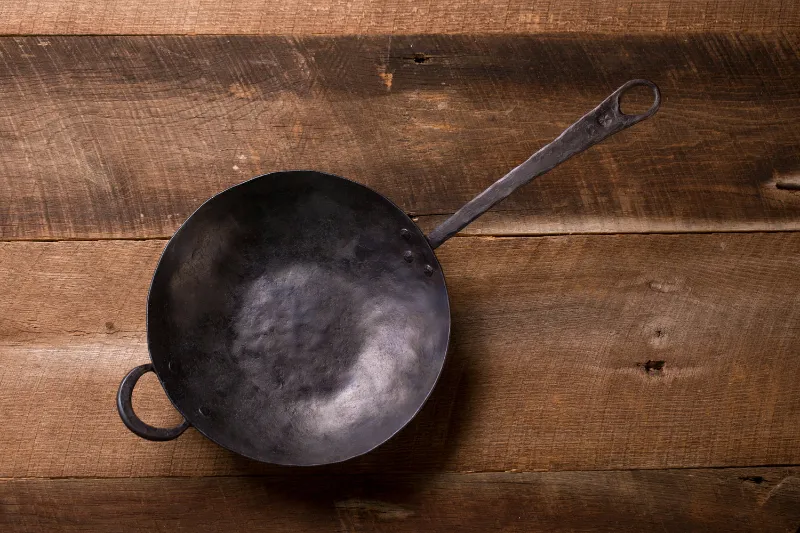
Versatile
The next benefit of using a carbon steel and cast iron wok is that it is very versatile. You can use it for a variety of different dishes, including stir-fries, steamed foods, and even deep-fried foods. This will help you to expand your culinary repertoire.
Portability
Carbon steel and cast iron woks are also very portable. This means that you can take them with you when you travel, so you can enjoy your favorite dishes no matter where you are.
Ease of Use
Another benefit of using a carbon steel or cast iron wok is that they are very easy to use. Even if you have never used one before, it will be easy to get the hang of it. Once you have used it a few times, you will be able to cook with it like a pro.
Price
These two woks are also very affordable, which is another benefit. If you are on a budget, then you will definitely want to consider investing in a carbon steel or cast iron wok. They are both very reasonably priced and will last you for many years to come.
Carbon steel woks are a good choice for people who want a durable wok that heats up quickly and has a non-stick surface. They are relatively inexpensive and come in a variety of sizes and shapes. If you are looking for a wok to experiment with, carbon steel woks are a good option.
No matter what size or type of wok you choose, carbon steel and cast iron woks are a great option for anyone who wants to be able to cook their food evenly and without any worries.
Carbon Steel Vs Cast Iron Wok: Difference
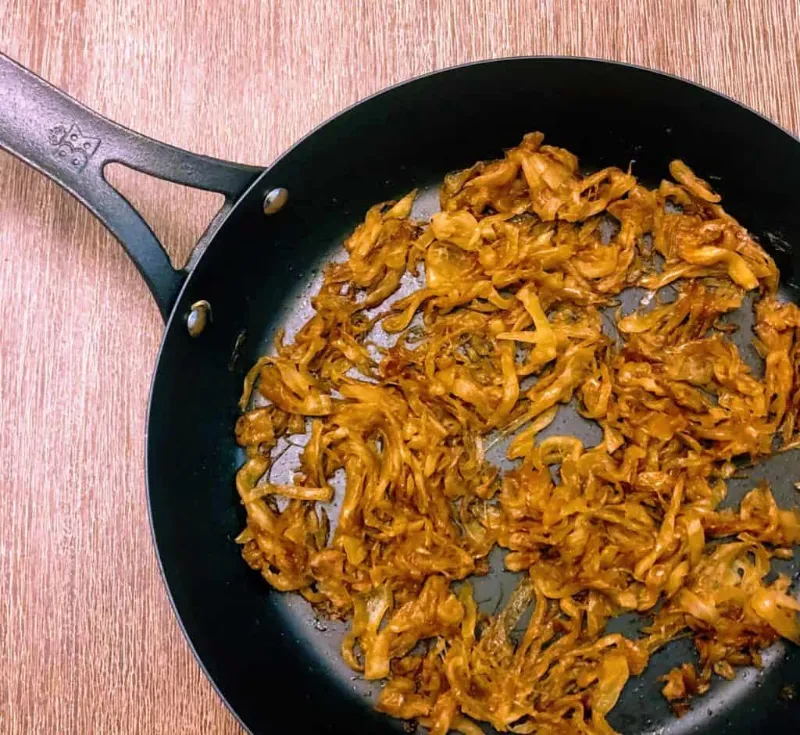
Materials
The first and most obvious difference between carbon steel vs cast iron wok is the materials. Carbon steel woks are made of, well, carbon steel. It is a combination of iron and carbon, making it harder and more durable than pure iron. Cast iron woks, on the other hand, are made of – you guessed it – cast iron.
Cast iron has a higher carbon content than carbon steel, which makes it more brittle. It is also more susceptible to rust and corrosion. However, cast iron woks have a few advantages over carbon steel woks. First, they are better at retaining heat. Second, they have a non-stick surface that makes them ideal for stir-frying.
Design
The next difference between carbon steel vs cast iron wok is the design. Carbon steel woks are typically made with a rounded bottom. This allows them to be used on gas or electric stoves, as well as over an open flame.
Cast iron woks, on the other hand, have a flat bottom. This makes them more stable on the stove, but it also means that they can only be used on gas or electric stoves – not over an open flame.
The design of the wok also affects the way that heat is distributed. Carbon steel woks have what is known as a “hot spot” in the center of the wok. This is because the heat is not distributed evenly across the surface of the wok. Cast iron woks, on the other hand, have better heat distribution because of their flat bottom.
Performance
When it comes to performance, both carbon steel and cast iron woks have their pros and cons. Carbon steel woks heat up quickly and evenly, making them ideal for high-heat cooking methods like stir-frying.
They are also less likely to rust than cast iron woks. However, carbon steel woks can be difficult to season properly, and they are not as good at retaining heat as cast iron woks.
Cast iron woks, on the other hand, take longer to heat up but retain heat better. This makes them ideal for slow cooking methods like braising and stewing. They are also non-stick, making them ideal for stir-frying. However, cast iron woks are more difficult to season and are more susceptible to rust and corrosion.
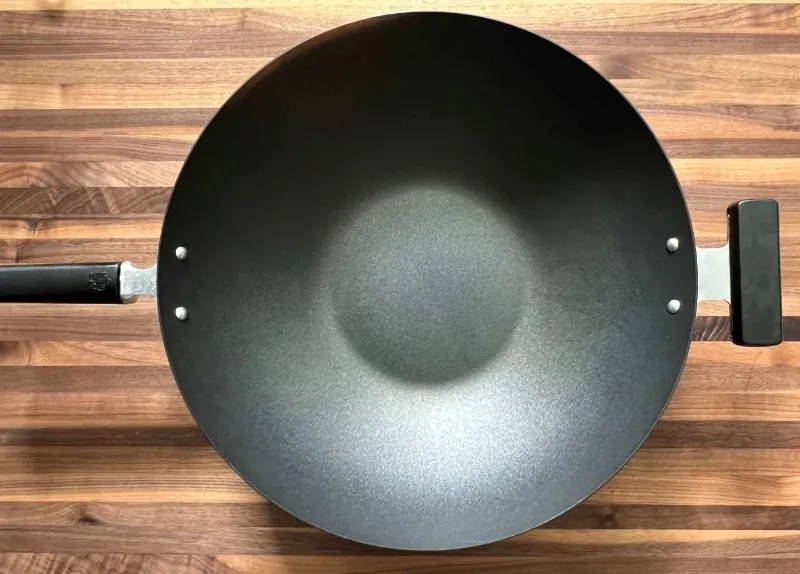
Usage
Another important difference between carbon steel vs cast iron wok is their intended usage. Carbon steel woks are typically used for stir-frying, while cast iron woks are often used for slow cooking methods like braising and stewing.
Both carbon steel and cast iron woks can be used for a variety of tasks, but each type of wok excels at different tasks. If you’re looking for a wok to use for stir-frying, carbon steel is the way to go. If you want a wok to use for slow cooking methods, cast iron is the better option.
Weight & Size
Another difference between carbon steel vs cast iron wok is their weight and size. Carbon steel woks are typically lighter and smaller than cast iron woks. This makes them easier to handle and store. Cast iron woks, on the other hand, are heavier and larger. This makes them more difficult to handle and store but also allows them to retain heat better.
Portability
When it comes to portability, carbon steel woks are the clear winner. They are lighter and smaller, making them easier to take with you on the go. Cast iron woks are more difficult to transport because of their weight and size.
However, both carbon steel and cast iron woks can be used for camping and picnicking. If you’re looking for a wok to take with you on the go, carbon steel is the way to go.
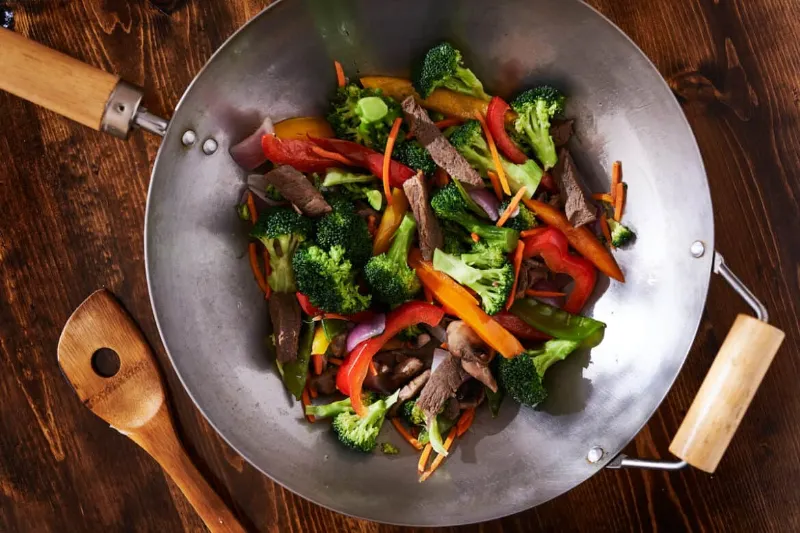
Ease of Use
Another important difference between carbon steel vs cast iron wok is their ease of use. Carbon steel woks are typically easier to use because they are lighter and have a non-stick surface. Cast iron woks, on the other hand, can be more difficult to use because of their weight and lack of a non-stick surface.
If you’re looking for a wok that is easy to use, carbon steel is the way to go. If you don’t mind a little extra effort, cast iron can be a great option.
Non-stick
One more difference between carbon steel vs cast iron wok is their non-stick properties. Carbon steel woks are not naturally non-stick, but they can be seasoned to create a non-stick surface. Cast iron woks are naturally non-stick because of their higher carbon content.
If you’re looking for a wok with a non-stick surface, cast iron is the way to go. If you don’t mind seasoning your wok, carbon steel can be a great option.
Versatile
When it comes to versatility, both carbon steel and cast iron woks have a lot to offer. Carbon steel woks are ideal for stir-frying, while cast iron woks are ideal for slow cooking methods.
Both types of woks can be used for a variety of tasks, making them both versatile options. If you’re looking for a versatile wok, either carbon steel or cast iron would be a great option.
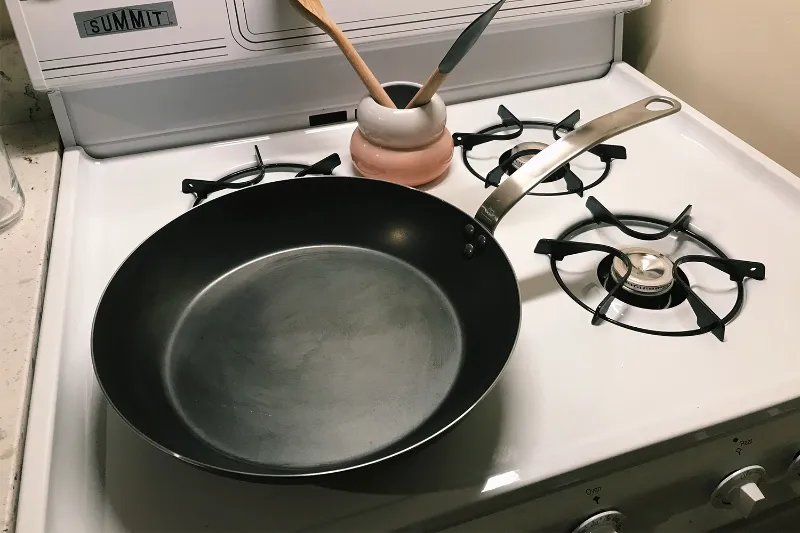
Cleaning and Maintenance
Cleaning and maintaining your wok is important to its longevity. Carbon steel woks need to be seasoned regularly to prevent rust and corrosion.
This can be a time-consuming process, but it’s necessary to keep your carbon steel wok in good condition. Cast iron woks also need to be seasoned, but they are less susceptible to rust and corrosion than carbon steel woks.
Both carbon steel and cast iron woks should be cleaned with hot water and soap after each use. Avoid using harsh detergents or scrubbing pads, as these can damage the seasoning on your wok. After cleaning, dry your wok thoroughly to prevent rust and corrosion.
Carbon steel woks are easier to care for and maintain than cast iron woks. Carbon steel woks also have a better heat distribution than cast iron woks, so they cook food more evenly. However, cast iron woks are more durable and can withstand high temperatures without warping.
Price
Finally, carbon steel vs cast iron wok differ in price. Carbon steel woks are typically less expensive than cast iron woks. This is because carbon steel is a more common material than cast iron. Cast iron woks are more expensive because they are made of a more esoteric material.
So, which type of wok is right for you? If you’re looking for a wok that is less expensive and easier to care for, carbon steel is the way to go. If you’re looking for a wok that is more durable and has better heat distribution, cast iron is the way to go. Whichever type of wok you choose, be sure to season it regularly and clean it after each use to keep it in good condition.
FAQs
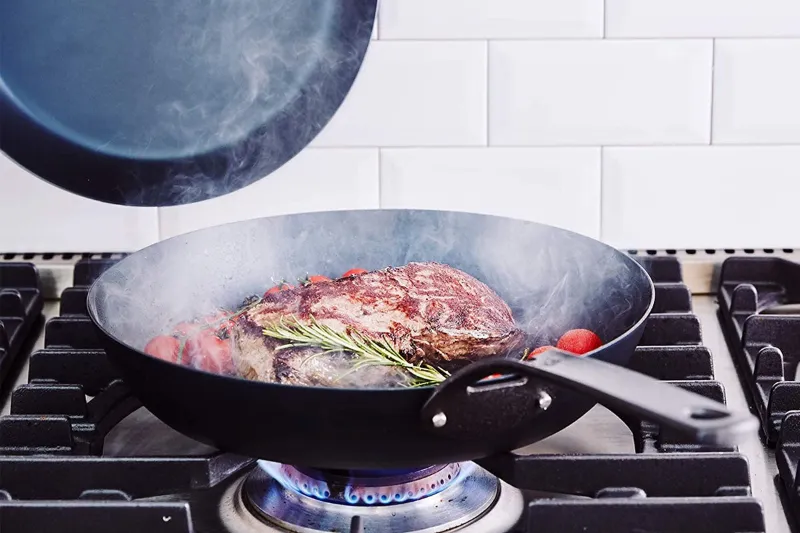
How do you season a carbon steel wok?
First, heat the wok over high heat until it begins to smoke. Then, add a small amount of oil and swirl it around the sides of the wok. Add your ingredients and cook them until they are done. If the food starts to stick to the wok, add a little more oil. You should season your wok before each use to keep it from rusting.
How do you clean a carbon steel and cast iron wok?
To clean a carbon steel wok, first remove any food particles by scrubbing with a soft brush or cloth. Then, rinse the wok with hot water and dry it immediately. If the wok is still dirty, you can boil a mixture of water and vinegar inside it. Finally, season the wok before using it again.
How do you prevent a carbon steel and cast iron wok from rusting?
To prevent a carbon steel or cast iron wok from rusting, you should season it before each use. Additionally, you should avoid using harsh detergents or scouring pads, as these can remove the seasoning and cause the wok to rust. Finally, make sure to dry the wok immediately after washing it.
However, it is inevitable that your wok will eventually rust. When this happens, you can remove the rust by scrubbing it with a mixture of salt and vinegar. Finally, re-season the wok before using it again.
Do I need to oil my carbon steel and cast iron wok?
Yes, you should always season your carbon steel and cast iron wok with oil before each use. This will prevent the wok from rusting and help to create a non-stick surface. Additionally, you can add a small amount of oil to the wok when cooking to prevent the food from sticking.
Conclusion
Choosing the right cooking vessel is important, and there are a few factors you should consider when making your decision. Carbon steel vs cast iron wok is a debate that has been around for years, and both materials have their pros and cons. Ultimately, it comes down to personal preference – so try out each material and see which one you like best.

Jen Lin-Liu is the founder of Black Sesame Kitchen. A Chinese-American writer and a nationally certified Chinese chef in Beijing. Jen is the author of two memoirs, Serve the People: A Stir-Fried Journey Through China and On the Noodle Road: From Beijing to Rome with Love and Pasta.

